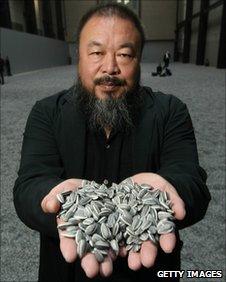Chinese artist Ai Weiwei's studio 'to be demolished'
- Published

Ai Weiwei is based in Beijing but had built a new, second studio in Shanghai
One of China's most outspoken artists, Ai Weiwei, has said he will throw a party to mark the forced demolition of his new Shanghai studio.
Mr Ai, who helped create the Olympic Bird's Nest stadium in Bejing, was initially invited to build the space in an emerging art district.
But, according to reports, the $1.1m (£670,000) studio has now been declared illegal and will shortly be demolished.
On Twitter, Mr Ai said he would offer river crabs at a final event.
"The 7th of November, 'River Crab Fest' at Ai Weiwei's Shanghai studio, which is about to be demolished...." reads a recent posting on his Twitter page.
It is thought that the choice of crabs is a political statement as the Chinese name for river crab sounds like "harmonise", a euphemism often used by the Chinese authorities for censorship.
It was not clear whether Mr Ai himself would be present at the event.
Born in 1957 in Beijing, the artist has played a key role in contemporary Chinese art over the last two decades, and has been highly vocal about human rights issues in the country.
Political art
Shanghai had imposed a six-month moratorium on large-scale building and demolition projects during the World Expo, in a bid to improve air quality, but reports say these have resumed since the exhibition ended.
"Ai's studio did not go through the application procedures, therefore, it is an illegal building," Chen Jie, director of the urban construction department in Malu township, where the studio is located, is quoted as telling the Global Times, external.
Mr Ai's latest work is currently on display in London's Tate Modern gallery: a giant installation made up of hundreds of thousands of tiny, hand-painted replica sunflower seeds.
100 million porcelain seeds are the latest installation at the Tate's Turbine Hall. Created by Chinese artist Ai Wei Wei.
Sunflower seeds are a popular Chinese street snack but also hold another meaning for the artist.
During the Cultural Revolution, propaganda images showed Chairman Mao as the sun and the mass of people as sunflowers turning towards him.
"The seed is a household object but at the same time it is a revolutionary symbol," Mr Ai has said of his work.
- Published11 October 2010